How behavioral health services address co-occurring disorders
Integrated Approaches in Behavioral Health for Dual Diagnosis Recovery

Understanding Co-Occurring Disorders and Their Impact
Co-occurring disorders, or dual diagnosis, involve the simultaneous presence of a mental health disorder and a substance use disorder within an individual. These intertwined conditions are characterized by overlapping symptoms that can complicate diagnosis and treatment, often influenced by genetic, environmental, and traumatic factors. Effective management necessitates integrated, person-centered approaches that address both conditions concurrently, aiming to improve long-term outcomes, reduce hospitalizations, and enhance quality of life.
Defining and Recognizing Co-Occurring Disorders
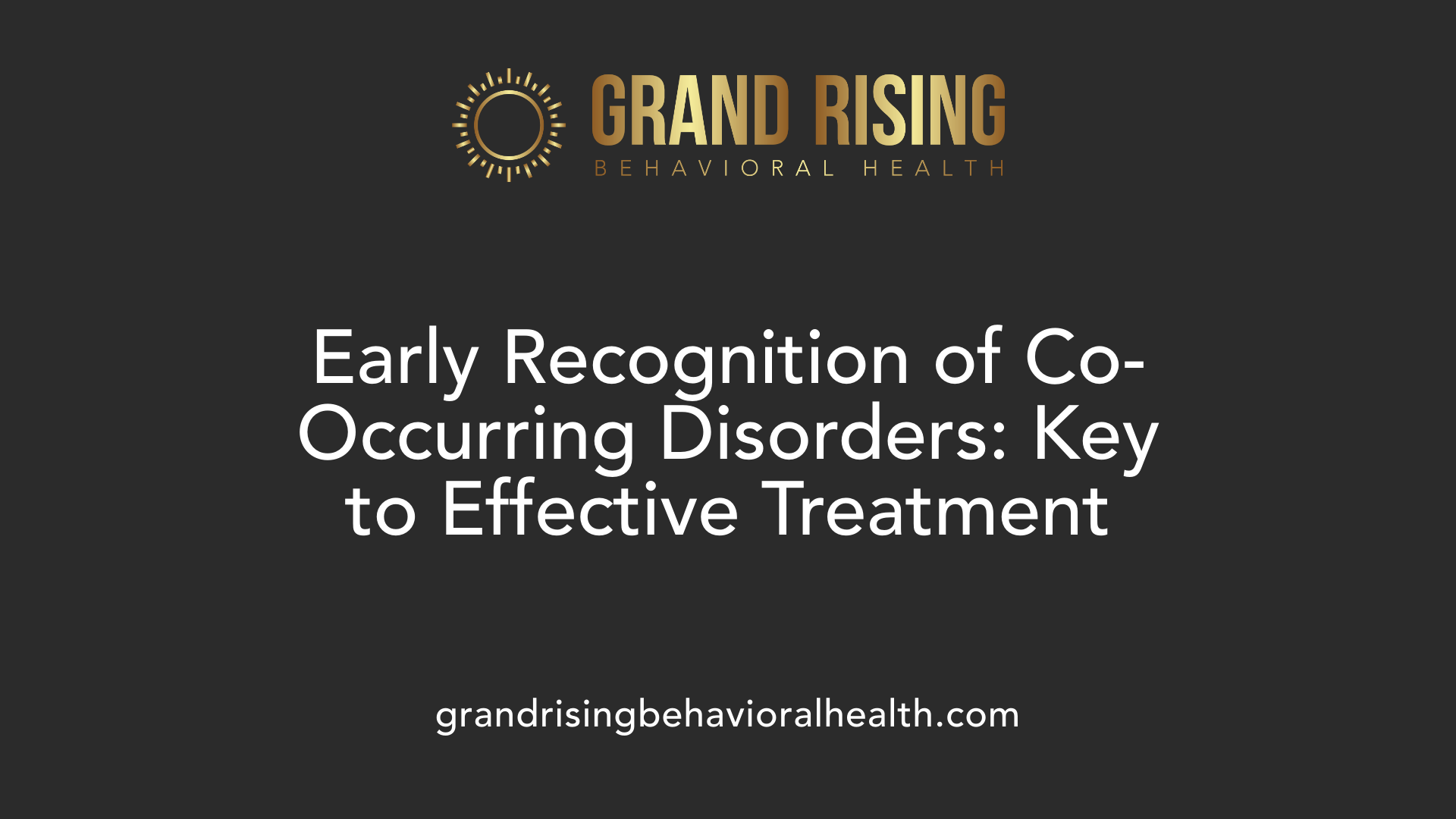
What are co-occurring disorders and their characteristics?
Co-occurring disorders, also known as dual diagnosis, refer to the presence of both a mental health disorder and a substance use disorder within an individual simultaneously. This intersection of conditions complicates diagnosis and treatment because symptoms can overlap, interact, and exacerbate each other.
Individuals with co-occurring disorders might experience a variety of mental health issues such as anxiety, depression, bipolar disorder, or schizophrenia alongside substance misuse problems like alcohol or drug dependence. These disorders can influence each other's onset and progression, often leading to more severe behavioral, emotional, and medical challenges.
The characteristics of co-occurring disorders include intertwined symptoms that make separation of the conditions difficult. For example, mood swings might be linked to depression or bipolar disorder but can also be intensified by substance use. Similarly, behavioral issues such as impulsivity or social withdrawal can stem from either or both disorders.
Genetic predispositions, trauma history, adverse social environments, and chronic stress are common causes that increase vulnerability to developing co-occurring disorders. The interplay of these factors can deepen the complexity of managing these conditions, resulting in higher relapse rates, increased hospitalization, and a greater social and health burden.
Effective management of co-occurring disorders requires integrated, personalized care that simultaneously addresses both mental health and substance use issues. This approach often involves multidisciplinary teams, psychotherapy, medication management, and ongoing support services to promote recovery and improve quality of life.
Understanding and early recognition of co-occurring disorders are vital for timely interventions, which can significantly enhance long-term outcomes and reduce the overall impact on individuals and healthcare systems.
What are the symptoms and causes of co-occurring disorders?
Symptoms of co-occurring disorders are multifaceted, involving behavioral, emotional, physical, and cognitive issues that reflect the mixture of mental health problems and substance misuse.
Common symptoms include mood swings, withdrawal from social activities, sleep disturbances, poor personal hygiene, risky behaviors, and difficulty functioning at work or school. Emotional symptoms might involve persistent feelings of sadness, anxiety, or irritability, while physical signs can include withdrawal symptoms, fatigue, or health deterioration.
The causes behind co-occurring disorders are typically rooted in shared or interconnected factors such as genetics, past trauma, stressful life events, and environmental influences. For instance, genetic vulnerabilities may predispose individuals to both mental health issues and addiction.
Trauma, especially early-life trauma, can lead to both mental health diagnoses and substance use as coping mechanisms. Social factors such as peer pressure, socioeconomic hardship, and exposure to substance-using environments also contribute.
Furthermore, symptoms can be mutually reinforcing; for example, untreated mental health issues might lead a person to self-medicate with alcohol or drugs, which in turn can aggravate mental health symptoms. This cycle makes treatment more complex but highlights the importance of integrated approaches.
Effective treatment must address both disorders concurrently, using evidence-based strategies like therapy, medication, and support groups. Early diagnosis and comprehensive intervention are crucial for preventing the escalation of symptoms and promoting sustained recovery and improved life functioning.
| Aspect | Details | Additional Notes |
|---|---|---|
| Main Conditions | Anxiety, depression, bipolar disorder, schizophrenia, substance misuse | Commonly co-existing mental and behavioral health issues |
| Symptoms | Mood swings, withdrawal, sleep issues, risky behaviors | Overlapping and interacting symptoms complicate diagnosis |
| Causes | Genetics, trauma, stress, adverse social environments | Shared risk factors increase likelihood of co-occurrence |
| Impact | Higher relapse, hospitalization, social challenges | Necessitates integrated treatment approaches |
| Treatment Models | Psychotherapy, medication, support services | Focus on addressing both conditions simultaneously |
| Prevention | Early detection, comprehensive care, trauma-informed approaches | Reduce long-term health and social issues |
Common Conditions in Co-Occurring Disorders
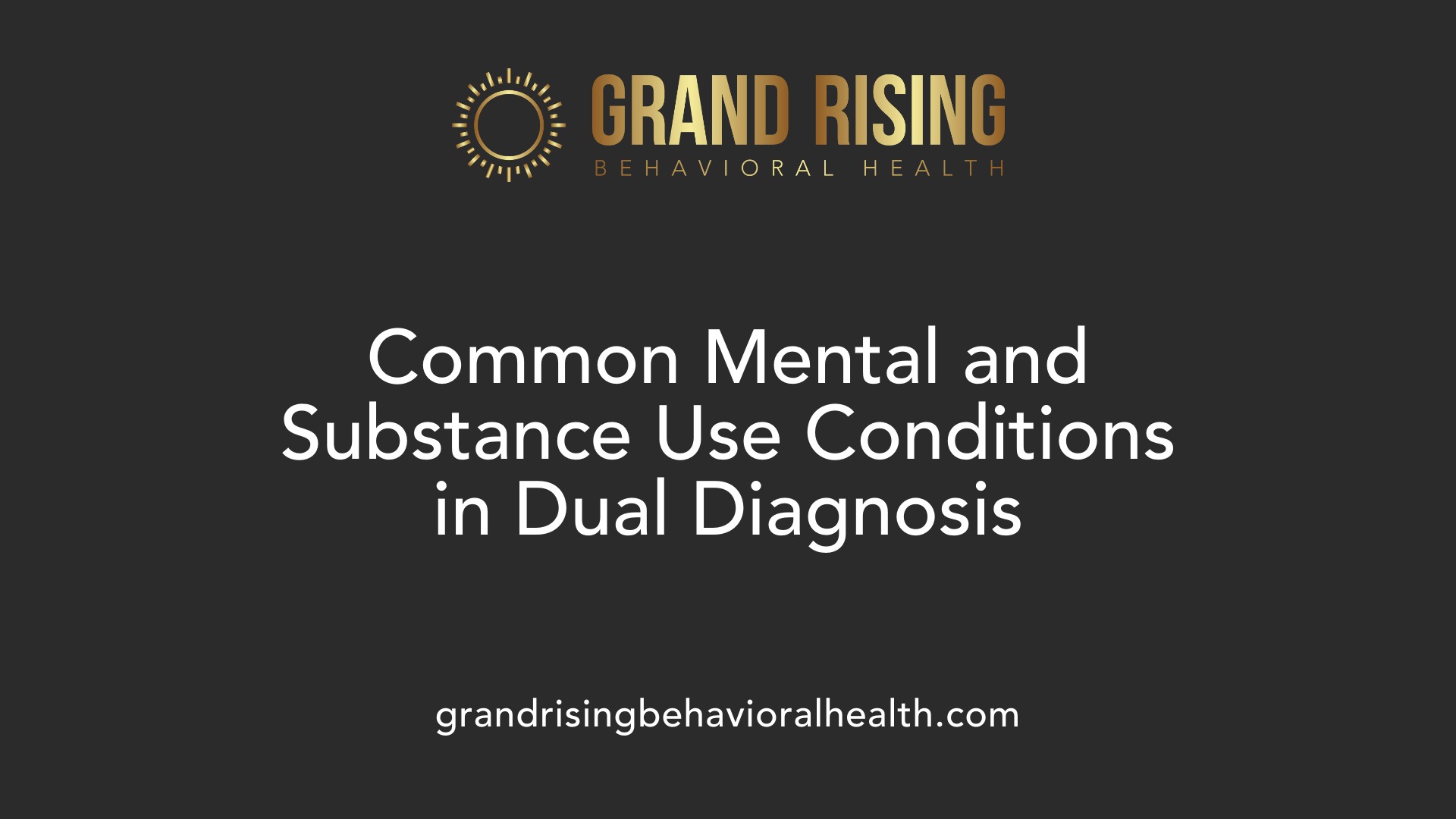
What are common mental health and substance use conditions involved in co-occurring disorders?
Co-occurring disorders, often called dual diagnosis, involve the simultaneous presence of a mental health condition and a substance use disorder (SUD). These overlapping conditions make treatment more complex, but understanding the common types involved can improve diagnosis and care.
Mental health conditions frequently observed with substance use disorders include:
- Depression
- Anxiety disorders, such as:
- Generalized Anxiety Disorder
- Panic Disorder
- Post-Traumatic Stress Disorder (PTSD)
- Bipolar disorder
- Schizophrenia
- Attention Deficit Hyperactivity Disorder (ADHD)
- Conduct disorders
- Personality disorders, notably Borderline Personality Disorder
On the substance use side, common issues involve:
- Alcohol
- Opioids, including heroin and prescription painkillers
- Stimulants like cocaine and methamphetamine
- Marijuana
- Hallucinogens
- Prescription medications
The high prevalence of co-occurrence stems from shared genetic, neurobiological, and environmental factors. For example, genetic predispositions can increase susceptibility to both mental health issues and substance use. Neurobiological changes in the brain's reward and stress systems also play significant roles. Environmental stressors, trauma, and social factors contribute to the development and persistence of these dual conditions.
When these disorders coexist, symptoms can worsen, making recovery more difficult. Mental health issues may lead to substance use as a form of self-medication, while substance use can worsen mental health symptoms, creating a vicious cycle.
Because of this intricate connection, clinicians emphasize the importance of integrated treatment approaches. Such strategies aim to address both mental illnesses and substance misuse concurrently, recognizing their intertwined nature. This comprehensive care increases the chances of recovery, reduces relapse, and improves overall quality of life.
In summary, the most common conditions in co-occurring disorders include depression, various anxiety disorders, bipolar disorder, schizophrenia, ADHD, conduct disorders, and personality disorders, combined with problematic use of alcohol, opioids, stimulants, and other drugs. Addressing these together through coordinated care is essential for effective treatment and better health outcomes.
Assessment and Diagnosis of Co-Occurring Disorders
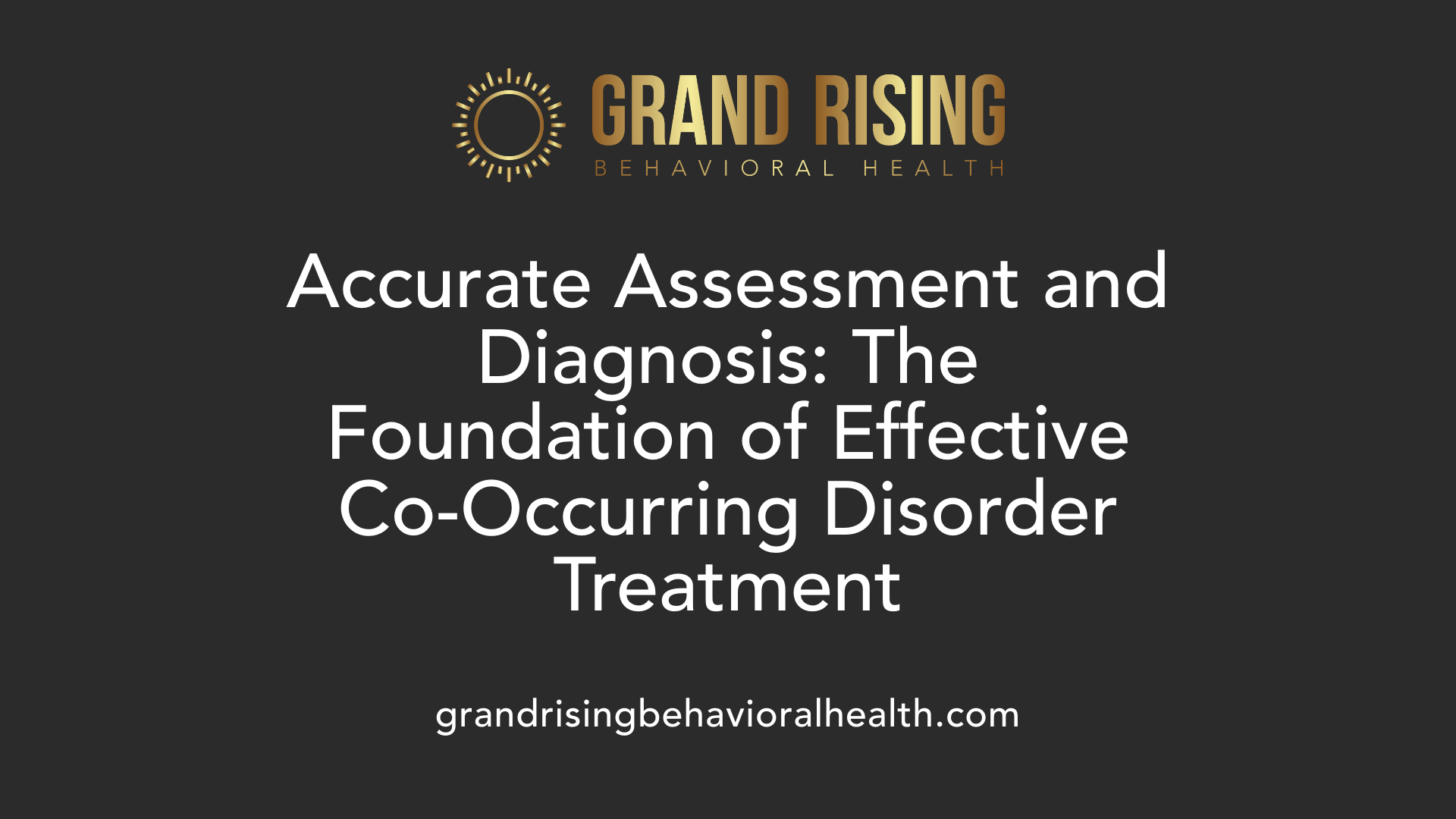
How are co-occurring disorders assessed and diagnosed?
Assessing and diagnosing co-occurring disorders involves a thorough, multidisciplinary approach that emphasizes accuracy and individualization. The process begins with initial screening, which uses validated tools to quickly identify individuals who may be at risk of having both a mental health disorder and a substance use disorder. These screening instruments help clinicians determine the necessity for more detailed assessment.
Following the screening, a comprehensive biopsychosocial evaluation is conducted. This assessment gathers extensive information about the individual’s background, including mental health history, substance use patterns, medical conditions, social circumstances, and cultural factors. Standardized assessment instruments, such as the Mental Health Screening Form III (MHSF-III), the Structured Clinical Interview for DSM-5 (SCID-5), or the Addiction Severity Index (ASI), are often employed to facilitate a detailed understanding.
Clinicians evaluate the severity of each disorder, safety considerations, the degree of functional impairment, and readiness to change. This step is crucial because it informs whether the disorders are primary, secondary, or interrelated, guiding appropriate treatment approaches.
Diagnosis relies heavily on clinical judgment guided by the Diagnostic and Statistical Manual of Mental Disorders, Fifth Edition (DSM-5) criteria. The clinician assesses symptom presentation, the level of impairment, and other contextual factors to ensure diagnostic accuracy.
An important aspect of assessment is ongoing monitoring and reassessment. As individuals progress through treatment, their symptoms, risk factors, and support needs may change, requiring updates to diagnoses and treatment plans.
Most effective assessments are personalized, recognizing that co-occurring disorders often have intertwined causes and presentations. The integration of multidisciplinary team input, including psychiatrists, psychologists, addiction specialists, and social workers, enhances diagnostic accuracy.
Ultimately, precise assessment and diagnosis enable the development of tailored, integrated treatment plans that address both mental health and substance use issues concurrently, which improves long-term outcomes and supports sustained recovery.
Treatment Strategies and Models for Co-Occurring Disorders
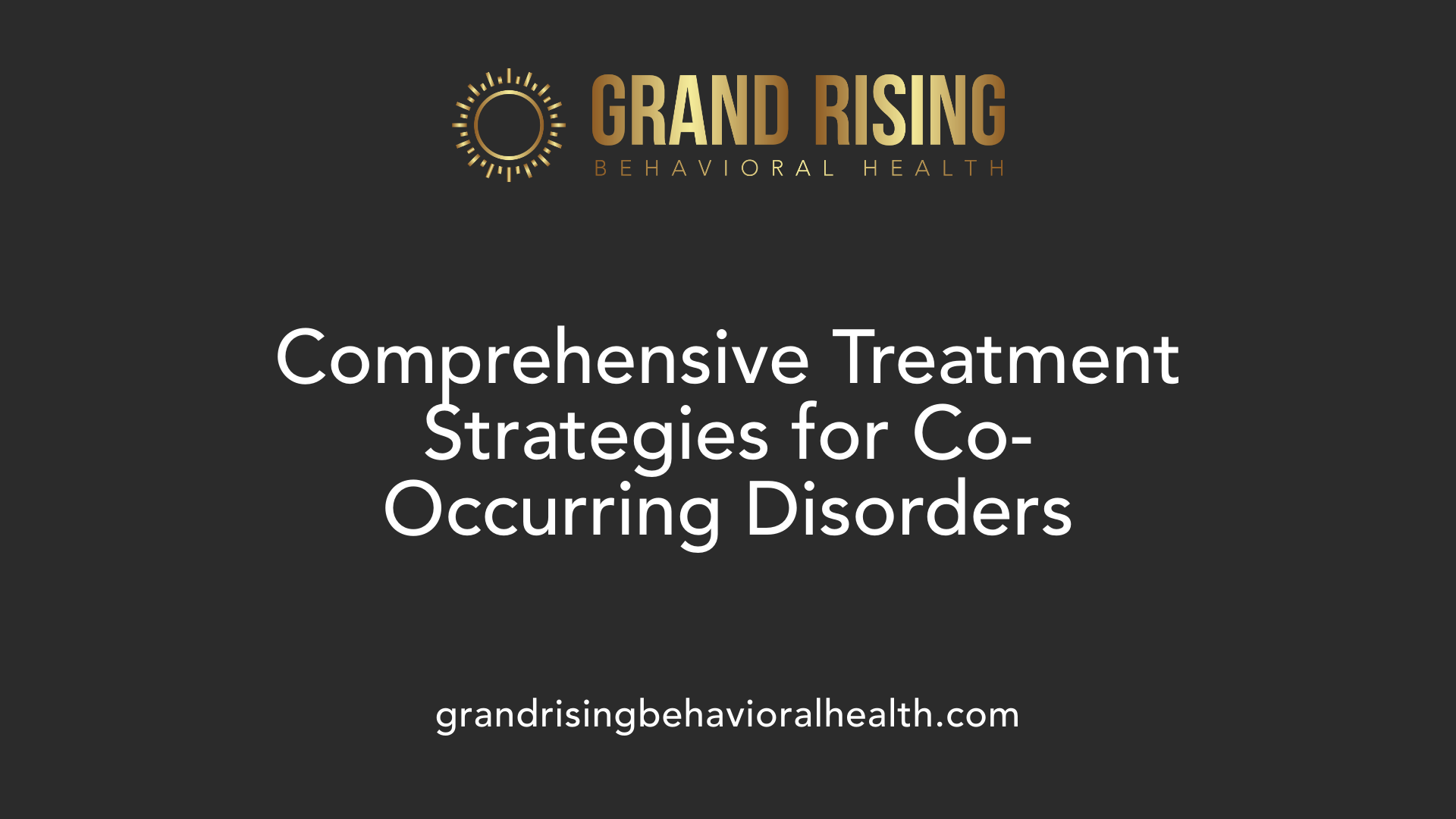
What treatment strategies and models are used for co-occurring disorders?
Effective treatment for co-occurring disorders relies on integrated, evidence-based approaches that simultaneously address mental health and substance use issues. These strategies are designed to improve overall outcomes, such as reducing substance consumption, alleviating psychiatric symptoms, and increasing treatment retention.
Behavioral therapies like cognitive-behavioral therapy (CBT) and dialectical behavior therapy (DBT) are central components, helping clients develop coping skills, manage emotions, and challenge negative thought patterns. To facilitate comprehensive care, various models are employed, including coordinated care, where providers work together; co-located care, where services are delivered in the same location; and fully integrated care, combining all services within a unified treatment plan.
Community-based approaches are also prominent. Assertive Community Treatment (ACT) and Intensive Case Management (ICM) provide ongoing support, emphasizing stability, recovery, and housing. These models are tailored to individual client needs, ensuring that treatment addresses personal circumstances.
Pharmacotherapy supports this integrated approach, with medications prescribed to control mental health symptoms and help reduce substance dependence. Close monitoring helps manage potential medication interactions and side effects.
Supporting interventions like motivational enhancement therapy and relapse prevention techniques reinforce engagement and foster long-term recovery. Building a strong therapeutic alliance through empathetic support and trust is essential for motivating clients and promoting sustained participation in treatment.
What are best practices and frameworks for addressing co-occurring disorders?
The most effective practices involve implementing comprehensive, integrated treatment models that coordinate mental health and substance use services within a single, cohesive system. Early screening and accurate assessment are critical, ensuring clinicians identify co-occurring disorders swiftly.
A foundational principle is the 'no wrong door' policy, guaranteeing that individuals receive appropriate care regardless of where they seek help, thereby reducing access barriers. Building a strong therapeutic relationship by fostering trust, cultural sensitivity, and recovery-oriented strategies forms the backbone of effective treatment engagement.
Evidence-based interventions include integrated pharmacotherapy, which addresses both mental health and addiction issues, and mutual-support groups that promote peer support and shared recovery experiences.
Models like Assertive Community Treatment (ACT) and Integrated Case Management (ICM) provide ongoing, personalized support, especially for those with complex needs who benefit from intensive and coordinated care.
Additional best practices involve strict confidentiality to protect client privacy, efficient use of assessment tools such as the Addiction Severity Index (ASI) and Structured Clinical Interview for DSM-V (SCID-5), and flexible approaches that adapt to individual mental health conditions.
Prioritizing holistic, person-centered treatment—tailored to individual circumstances—has been shown to improve outcomes. Ultimately, adopting these frameworks enhances clients' quality of life, reduces hospitalizations, and supports sustained recovery.
Benefits and Outcomes of Integrated Treatment
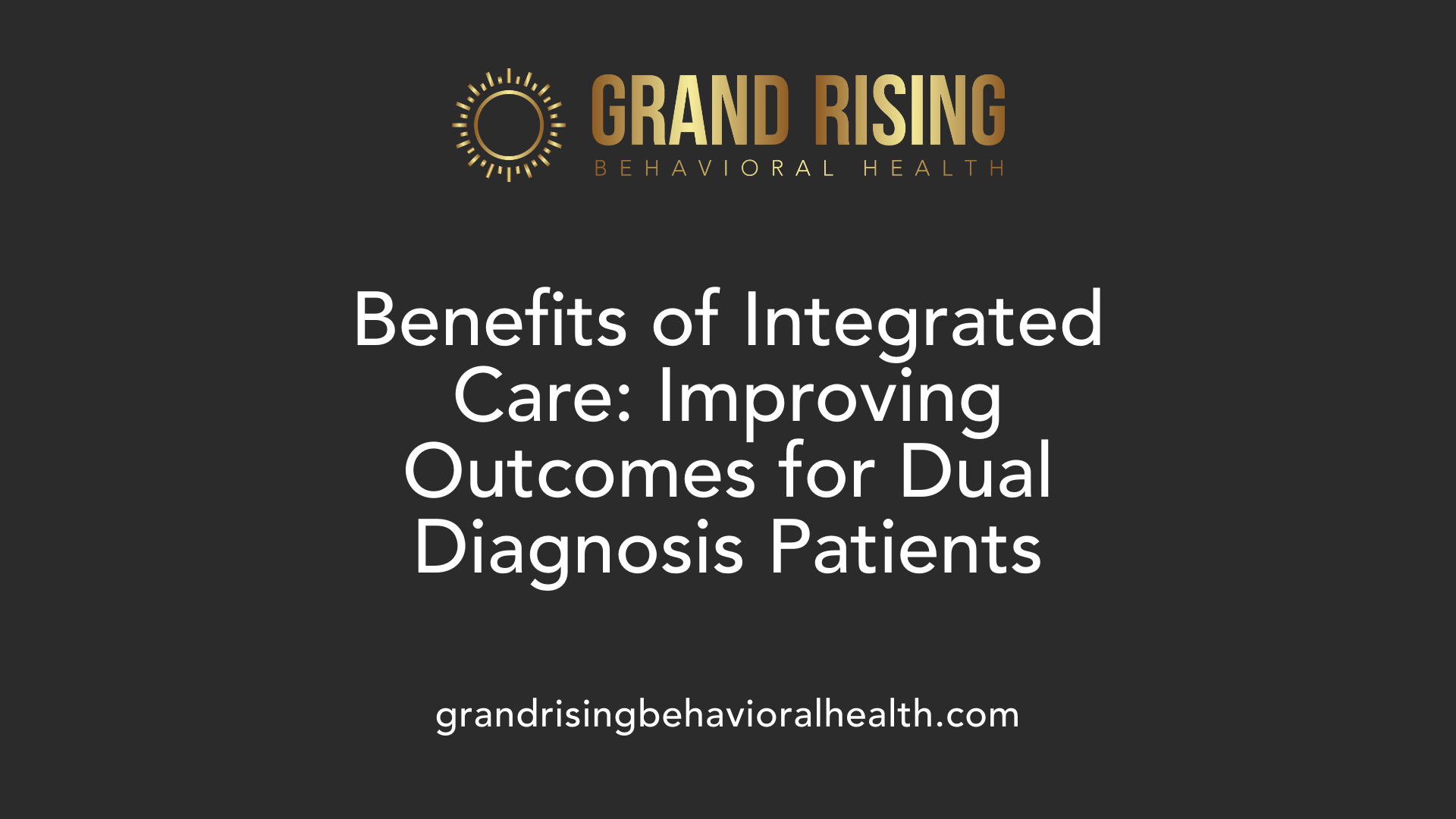
What are the benefits and outcomes of integrated treatment for individuals with dual diagnoses?
Integrated treatment provides a comprehensive approach tailored for individuals facing both mental health and substance use disorders. One of its primary benefits is the significant reduction in psychiatric symptoms such as PTSD, anxiety, and depression, which are often intertwined with substance abuse issues. This dual focus not only alleviates mental health symptoms but also enhances motivation for engaging in substance use treatment, leading to higher adherence and commitment.
While integrated care may not always produce greater reductions in substance use compared to traditional, non-integrated methods, it consistently outperforms separate treatment models in managing mental health symptoms and improving overall functioning. Patients often experience fewer hospitalizations and a lower likelihood of relapse thanks to the coordinated support addressing all aspects of their health.
Moreover, this approach promotes better quality of life by facilitating long-term recovery and stability. The holistic nature of care—combining therapy, medication management, support groups, and ongoing monitoring—helps individuals develop healthier coping skills, regain independence, and rebuild relationships.
Effective integrated programs also foster strong therapeutic alliances, which are vital for engagement and success. Supportive, empathetic, and culturally responsive care reduces stigma and barriers, encouraging clients to stay involved in their recovery journey.
Overall, the outcomes of integrated treatment include increased treatment retention, improved mental health, reduced hospital stays, and enhanced overall well-being. These combined effects contribute significantly toward a sustainable recovery path and better health outcomes for individuals with dual diagnoses.
| Benefits of Integrated Treatment | Outcomes | Additional Details |
|---|---|---|
| Reduction in psychiatric symptoms | Better mental health management | Treats underlying issues concurrently |
| Increased engagement in treatment | Higher retention rates | Encourages continued participation |
| Decreased hospitalizations | Fewer acute care episodes | Supports community-based recovery |
| Lower relapse rates | Sustained sobriety | Addresses triggers and risk factors |
| Improved quality of life | Holistic well-being | Enhances daily functioning |
| Better treatment satisfaction | Client-centered experience | Builds trust and rapport |
| Enhanced functioning in daily life | Independence and stability | Supports employment and social roles |
Understanding these benefits emphasizes the importance of integrated care models in effectively addressing the complex, interconnected needs of individuals with dual diagnoses. Continued research and program development reinforce the positive impact of integrated treatment on health and recovery outcomes.
For more insights, search for “Outcomes of integrated care in dual diagnosis treatment” to access recent studies and evidence-based program evaluations that highlight these positive results.
Systems and Program Organization for Managing Co-Occurring Disorders
How are system and program organizations designed to manage co-occurring disorders?
Effective management of co-occurring disorders relies on well-structured systems and programs that emphasize integrated care models. These models include coordinated, co-located, and fully integrated care approaches, which promote seamless collaboration among mental health services, substance use treatment providers, and supportive community resources.
A fundamental aspect of system design is early detection. Routine screening for mental health issues and substance use disorders is embedded within various entry points of behavioral health services. This ensures individuals receive timely assessments regardless of the setting they visit, aligning with the 'no wrong door' approach that guarantees access to appropriate care.
Once screened, individuals are linked to tailored interventions through a collaborative care framework. The care delivery often involves a multidisciplinary team that combines behavioral therapies such as cognitive-behavioral therapy (CBT), dialectical behavior therapy (DBT), medication management, and family-based interventions. This holistic approach addresses both mental health and substance use issues concurrently, rather than sequentially, which has been shown to improve outcomes.
System organization emphasizes strong leadership at the policy and program levels. Leadership commits to establishing clear goals, aligning funding streams, and crafting regulations that support full integration of services. Supportive policies facilitate the development of accessible, comprehensive services suited to diverse populations.
To continually improve quality and effectiveness, systems incorporate ongoing evaluation mechanisms, such as performance measurement and quality assurance standards. Data collection and analysis help identify gaps in service delivery, inform policy adjustments, and demonstrate program success.
Training and workforce development are also central to system success. Programs invest in specialized training for clinicians, peer support staff, and administrators to enhance competence in integrated treatment modalities. Continuous education ensures providers stay current with evidence-based practices.
Investment in research and innovation remains vital. Pilot programs, treatment protocols, and technological solutions like telehealth expand access and adapt services to meet evolving community needs.
Furthermore, addressing systemic barriers—including financial constraints, stigma, and service fragmentation—is crucial. Funding mechanisms such as grants, insurance reimbursements aligned with parity laws, and integrated care initiatives help overcome these obstacles.
In conclusion, system and program organizations are strategically designed to deliver comprehensive, person-centered, and recovery-oriented services. Through integrated models, effective leadership, supportive policies, and continuous quality improvement, these systems aim to improve health outcomes for individuals coping with co-occurring mental health and substance use disorders.
Holistic and Comprehensive Care Approaches
What comprehensive and holistic care approaches are used in treatment?
In treating co-occurring disorders, adopting comprehensive and holistic care strategies is vital for addressing all aspects of an individual's health. These approaches go beyond traditional treatment methods by integrating medical, psychological, social, and even spiritual interventions.
Multidisciplinary strategies are often employed, combining evidence-based therapies such as cognitive-behavioral therapy (CBT), motivational interviewing (MI), and trauma-focused counseling. These therapies help individuals understand their conditions, develop healthier coping skills, and process underlying trauma or emotional issues.
Emphasizing the mind-body connection, holistic models incorporate stress reduction techniques including mindfulness, relaxation exercises, meditation, and breathing techniques. These methods help manage anxiety, reduce relapse triggers, and promote emotional regulation.
Complementary therapies also play a role. Herbal medicine, aromatherapy, acupuncture, and massage therapy are used to support physical wellness and emotional stability, providing a more comprehensive healing process.
Supporting physical health is another cornerstone — physical activity, proper nutrition, and sleep hygiene are promoted to enhance overall well-being, energy levels, and mood stability.
Creative therapies such as art therapy, music therapy, and dance movement therapy allow individuals to express emotions non-verbally and foster personal insight. These activities can improve self-awareness and facilitate emotional release.
Building a strong, trusting therapeutic alliance is crucial. Culturally responsive care ensures that treatment respects and incorporates an individual’s cultural background, beliefs, and preferences, which enhances engagement and adherence.
Ongoing recovery support, including participation in support groups and community resources, is vital for maintaining long-term health gains. This continuous support fosters resilience and empowers individuals to sustain their recovery.
Overall, holistic and comprehensive care in treating co-occurring disorders aims to treat the whole person—not just the symptoms—by addressing physical health, mental health, lifestyle, and social relationships in a coordinated and personalized manner.
Wrapping Up: The Future of Addressing Co-Occurring Disorders
The evolving landscape of behavioral health emphasizes integrated, person-centered, and holistic approaches to managing co-occurring disorders. Advances in evidence-based practices, system organization, and community engagement are leading to better health outcomes, reduced hospitalizations, and sustained recovery for individuals facing dual diagnosis challenges. Continued investment in training, research, and policy reform will be vital to ensuring accessible, effective, and culturally responsive care across all treatment settings, ultimately transforming the way healthcare systems respond to the complex needs of this population.
References
- Managing Life with Co-Occurring Disorders - SAMHSA
- Co-occurring behavioral health conditions: What are they and how ...
- Chapter 5—Strategies for Working With People Who Have Co ...
- Co-Occurring Disorders and Other Health Conditions - SAMHSA
- Recommendations for Integrated Systems and Services for People ...
- Co-Occurring Disorder Treatment: Addressing Mental Health And ...
- Co-Occurring Disorders - Psychology Today
- Dual Diagnosis: Definition & Treatment - Cleveland Clinic
- Co-Occurring Disorder Treatment Centers Near Me
More Resources
A team ready to start your journey.
Get in touch — today.
We are a safe space – a haven for exceptional individuals to receive discreet, personalized, in-person treatment and care.
.avif)










